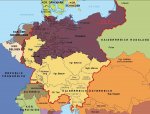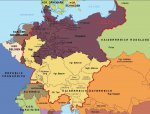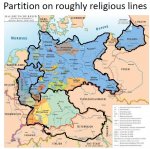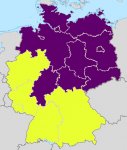ITTL, France elects to intervene militarily in the Austro-Prussian War of 1866, as many prominent French figures had advocated for once it became clear that, contrary to pre-war expectations, the Austrians were losing badly to the Prussians. As such, Napoleon III implements an armed mediation consisting in a mobilization and the massing of troops at France's eastern borders while the bulk of the Prussian armies were still engaged in Bohemia, as a warning that no territorial changes could be effected in Germany without consulting France. As such, Bismarck's hopes of making peace with Austria rapidly enough to forestall intervention by France or Russia are dashed, and with continuing the war in hopes of further gains being even less tenable than IOTL, the Prussians are forced to reach a peace agreement on markedly more equal terms.
And in the aftermath, at TTL's
Peace of Prague, after the dissolution of the German Confederation as was the case IOTL (with the OTL's treaty having been explicitly excluded Austria from German affairs from then on, and allowed Prussia to create a new
Bundesverhältnis in the North of Germany- as well as having allowed the South German states to create their own South German Confederation, which Napoleon III had hoped would be inevitably form and be led by Bavaria, by way of which Germany could be properly 'divided and conquered' and both the Palatinate and Saarland more easil reconquered and annexed; but failed to ever materialize IOTL), TTL's peace agreement instead solely excludes Austria from German affairs north of the River Main, resulting in Prussia's creation of the North German Confederation being paralleled by Austria's creation of its own South German Confederation. This only serves to further ramp up the Austro-Prussian Rivalry, as well as further delaying the Austro-Hungarian Compromise, which in turn is given markedly less priority ITTL.
This also significantly improves relations between Austria and France, to the extent where the South Germans initially choose to remain neutral in TTL's Franco-Prussian War, which is a markedly more hard-fought and closely-contested affair as a result, with French forces being spread far less thinly in the initial defensive phase of the conflict (with OTL's French plans for its main army to invade the Bavarian Palatinate, and proceed to "free" the four South German states in concert with Austro-Hungarian forces, being rendered redundant and wholly counter-productive ITTL with these states already members of Austria's South German Confederation) also being a factor, and drags out into the lengthier war which neutral observers had expected it to become. And after the conclusion of TTL's Franco-Prussian War (regardless of which way it goes, but even more so if Prussia still wins), the alliance which had been proposed in 1868, between France, Italy, and Austria (and by extension, the South German Confederation), is confirmed; even further entrenching the North-South German divide, and Catholicism and Protestantism as markers of North and South Germany's fledgling national identities.















